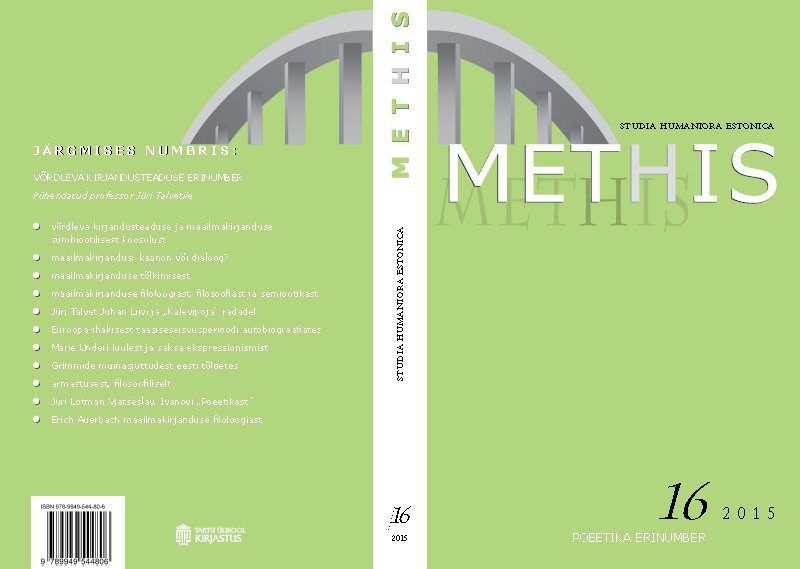Vanaheebrea luule poeetika, juhatuseks / Ancient Hebrew Poetry: An Introduction to Its Poetology
DOI:
https://doi.org/10.7592/methis.v13i16.12450Keywords:
vanaheebrea luule, piiblikirjandus, poeetika, mõtteriim, Jesaja, ancient Hebrew poetry, biblical literature, poetology, parallelism, IsaiahAbstract
Teesid: Põhiliselt 8.–3. sajandil e.m.a tekkinud vanaheebrea luules on põhiühikuks bikoolon ehk kahest koolonist koosnev värss (esineb ka trikooloneid, mis on aga mõnikord bikooloni sekundaarsed laiendused). Enamik värsse kasutab mõtteriimi, mida saab seletada aspektiivse mõtlemisega. Ülejäänud värsid on täiendavat laadi. Värssidest moodustatakse alastroofe, stroofe ja terveid poeeme, mida aitavad kujundada abielemendid, nagu ulatuslikud kõlamängud, võtmesõnad, anakruus, ellips, kiasm, inklusioon jms. Lähemalt vaadeldakse nii sünkroonselt kui diakroonselt Jesaja raamatu ühte tervikpoeemi (24,6–13).
SUMMARY
This poetological paper aims to introduce the reader to ancient Hebrew poetry in Estonian. In preparation for reading Old Testament poetry, one should first be acquainted with the principles and most popular poetic figures of ancient Hebrew literature composed mainly from the eighth to third centuries BCE. This paper uses a hierarchical method of instruction, beginning with basic elements, such as half-lines or lines of verse (denoted here as cola and bicola respectively, and not excluding tricola), and then moving to larger units, such as a sub-strophes, strophes (stanzas), and lastly an entire poem.
A bicolon can be considered the basic unit of ancient Hebrew poetry, and it is genuinely parallelistic. Parallelism is introduced to readers via an aspective way of thinking (cf. Emma Brunner-Traut). The author analyses two verse types, widely known as synonymous and antithetic verses as synonymous verses, since in some verses, using a pair of antonyms does not give sufficient reason to say that the verse is itself antithetic. The phenomenon of tricola is regarded in diachronic terms: many occurrences of tricola in the Hebrew Bible result from the addition of a secondary colon to the original bicolon sometime during the later centuries (so already Sigmund Mowinckel). Genuine tricola exist as well but are found mostly within certain genres, such as hymns. Verses that do not categorise as synonymous parallelism can be classified as extrapolative verses that are either synthetic (with the second colon reasoning the first or adding a completely new perspective) or instances of enjambment.
Additional elements, such as sound figures, assist in the composition of smaller or larger poetical units, including alliteration and assonance, occasional end-rhyme or anacrusis marking the beginning of a poetical unit, ellipsis, chiasmus, inclusio, etc. The reader should especially take note of keywords that characterise a verse, a strophe, or a poem.
Using all of the above-listed poetic elements and figures, the author analyses the poem Isaiah 24:6–13, which belongs to the Apocalypse of Isaiah in chapters 24–27 and can be parsed into two literary layers written by different scribal hands (bicola in vv. 6–7, 9–10, 12–13 and tricola in vv. 8 and 11). In its present form, the poem consists of four strophes (6, 7–9, 10–12, 13), but evidence suggests that it originally consisted only of two strophes, which were then divided into two sub-strophes of two bicola (6–7+9 and 10+12–13). This paper illustrates the extensive sound play, the complex network of keywords, and the patterns of anacrusis found within the poem. The synonymous verse type dominates, even in tricola, but within the poetic framework, extrapolative bicola prevail.


